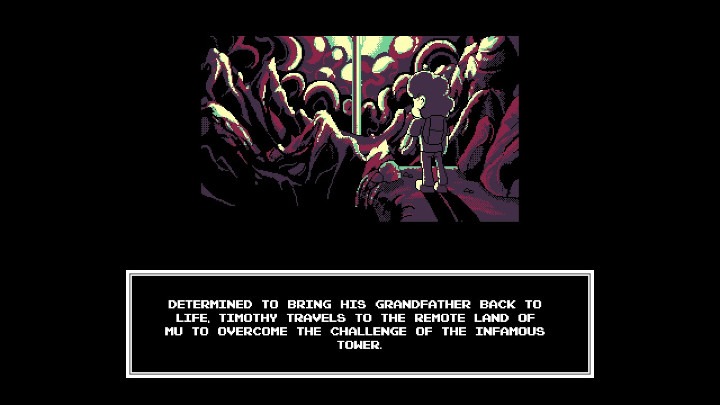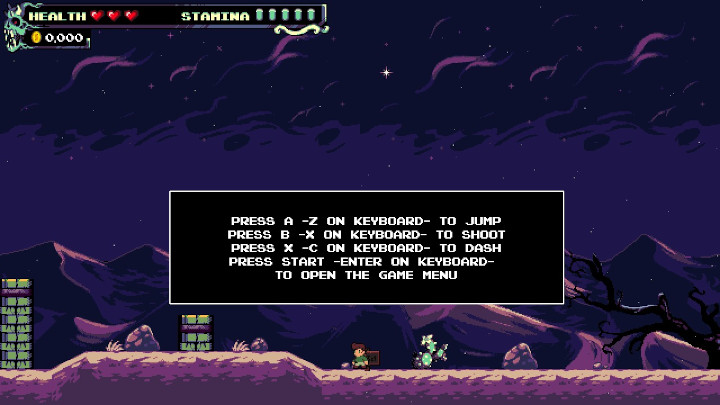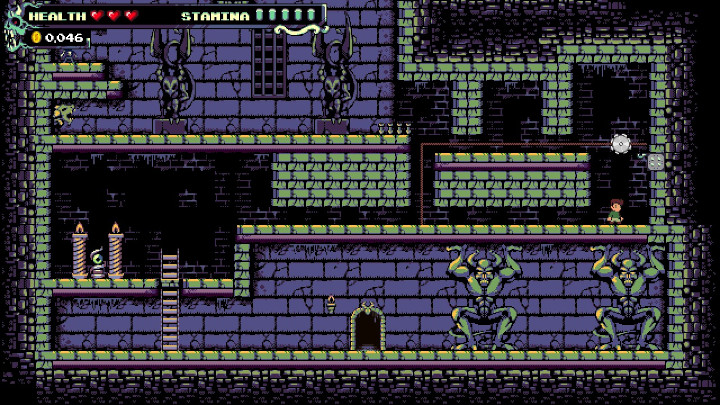
The benefit of any retro throwback game is that modern-day game developers are working with far more power and resources than they would have had on, say, the original Nintendo Entertainment System. So you can make games that look and feel like long-forgotten NES games, but with the benefits of modern tech so you can have more colors on the screen at once, and more enemies onscreen without seeing slowdown. You can also build stage layouts and game mechanics that are far too complex to ever work on old hardware from the 1980s.
However, you can still give these games the look and feel of their ancestors by using pixel art and chiptune soundtracks. I tend to be really drawn to these sorts of games. I adore pixel art, I’m a sucker for a good 2D platformer, and I get really excited about chiptune soundtracks.
So on paper, Timothy and the Tower of Mu has a lot going for it. It’s a retro throwback 2D platformer with an 8-bit visual style and a chiptune soundtrack. However, it has a lot of problems that make it feel more like a long-forgotten piece of NES shovelware rather than a lovingly crafted throwback.
First off, the game’s intro is way too long. Everything you need to know about the story is in this one image:

But instead of just giving you a couple sentences and letting you go wild, this intro goes on and on and on… Seriously, this whole story could have been told in one image, and if they really wanted to flesh it out, they could have done so in maybe three or four images. Instead, there are 14 slides here, which feels extreme for a game like this that really doesn’t need an elaborate setup.
But that’s a minor gripe in the grand scheme of things. Much worse than that is the fact that the controls feel awful. Jumping feels floaty. Timothy can grab objects on the side of walls, but it feels hit or miss whether he actually does this or not. I’m not sure if this was a product of me using the analog stick on the Xbox controller instead of the D-pad, but it feels really awkward.
Timothy also has a slingshot, which feels like it has a delay on it. This delay is so pronounced that I initially didn’t even realize I could fire projectiles at all — I had pushed the appropriate button multiple times without anything happening, so I originally assumed I would have to unlock the slingshot later on and I pressed through the first section of the game without shooting anything. If you want to actually fire your slingshot, you really need to hold down that B button (or X on your keyboard). Tapping the button won’t be enough.
The air dash is the game’s redeeming feature, as far as controls are concerned. It actually feels really nice, and if you air dash a lot, you can kind of mitigate the floatiness of your jumps. In fact, there’s a precision to this one move that’s lacking in both the jump and the slingshot.

I also found the first save point to be broken. I saved here, then died, and my game froze. I restarted the game and tried to load the save, but the game just hung for like ten minutes before I shut it down and started over (I had set my controller down and went off to do some other things around the house while I was waiting for the game to load). I did start a fresh save to test out this save point, and it did work on the next playthrough. The problem, though, is that it makes me really hesitant to invest too much time into the game, knowing that my save file could be corrupted at any time, forcing me to restart once again.
There are also a lot of weird design issues that make it seem like not a lot of thought was put into the game. For example, in the game’s first shop, Strange Meat costs 10 gold and heals 1 HP, while Rat Burger costs 25 gold and heals 2 HP. Why would anyone ever buy the more expensive healing item when two of the cheaper option will still cost less than the more expensive one?
And this is just a personal quibble, but the shopkeeper is the most punchable NPC I’ve encountered in a video game since Open Country‘s Gary. I really don’t like this guy.

And these bizarre design choices aren’t just limited to shop prices and NPC aesthetics. The level design feels way off as well.
For example, the first moving platform in the game has a bend in its movement. So, the platform moves straight up or down, but when it hits a certain point, it bends diagonally to move down and to the right. This doesn’t sound like a big deal — and I suppose it really isn’t — but in a platformer, your first moving platform should serve as an unspoken tutorial. It should move either straight up and down or straight to the left or right. Then throw in a diagonally moving platform once you’ve established the moving-platform mechanic. If you really want to introduce platforms that shift direction, you should only do it after you’ve introduced straight-moving platforms. Additionally, you should probably mark the trajectory of your platforms, the way Super Mario Bros. 3 does. Weirdly, the moving sawblades in Timothy and the Tower of Mu actually have lines behind them to mark their trajectories.
I’ve also encountered enemies that seem to be placed in the worst possible spots, where the frustrating timing of your slingshot makes jump-shooting almost impossible — you’ll either shoot above the enemy’s head or beneath its feet. With a decently responsive attack button, this wouldn’t even be an issue, but here it can be downright brutal.
Now, this is actually a sequel to a game called Timothy and the Mysterious Forest. I never played the previous game, but it appears to be a Zelda-like rather than a platformer. I am somewhat intrigued based on the screenshots I’ve seen, but considering how much frustration Timothy and the Tower of Mu has already caused me, I don’t think I’ll be checking out the previous game any time soon. Plus, the reviews weren’t great.
It seems to me that instead of dabbling with a new genre, developer Kibou Entertainment should have worked on polishing what didn’t work in the previous game. Clearly, this is a developer with a lot of talent for visual design, with wonderful 8-bit pixel art and a limited color palette that gives the whole thing a more authentic retro vibe. But the gameplay mechanics feel frustrating at best (and completely broken at worst), and there are a lot of general issues with design that could probably be cleared up with some revision work.

I really wish Timothy and the Tower of Mu wasn’t so flawed, because it does have a lot of potential. But with so many other great throwback games this year — such as Demon Throttle and Infernax — Timothy and the Tower of Mu just doesn’t have what it takes to win me over. Admittedly, I only played this for about 90 minutes, so I can’t really call this a proper review. But the game’s Steam page claims this has 10 to 40 hours of gameplay, and I can’t even imagine having the monumental endurance it would take to stick with this for that long. Especially when a save file can just clunk out at any time and force a complete restart.
Disclaimer: I was given a review code for Timothy and the Tower of Mu on Steam, but the opinions expressed in this article are my own.